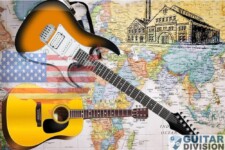What Is the Loudest Acoustic Guitar? (We Found Out!)
A common question amongst guitarists revolves around what brands and models of acoustic guitars are the loudest.
Whether you’re playing unplugged acoustic with a modern band, with loud orchestral instruments, or need some kung-pow volume for fast pickin’ bluegrass, then you’ll need a big cannon for the job.
We’ve done some research into what musicians think about various guitar models, types, and woods used to make them – and which combinations are loudest (please mind your tone though!).
If you ask other guitarists what the loudest acoustic guitar is, you will be met with a barrage of different answers depending on individual experience. There is no single answer to this question, but most guitarists agree that an Advanced Jumbo is normally the loudest guitar type.
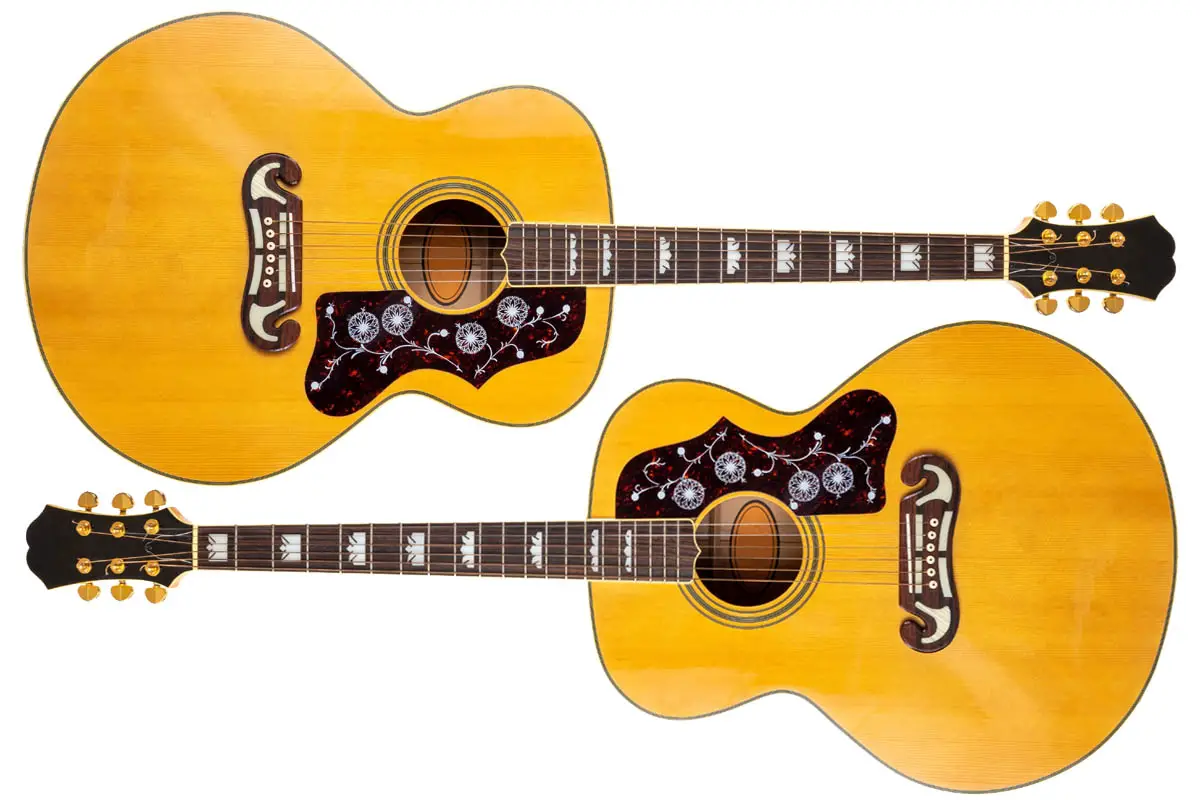
There are a few guitar makes that pop up in conversations regularly like Collings, Breedlove, Taylor, Guild, and of course Gibson notably for their AJ-200’s.
There is also another guitar that packs a punch, and it’s made by the Rainsong instrument company from carbon fiber.
Further down we have made a list of guitars that are known to be loud, and they are sorted by manufacturer, body shape, and 6 or 12 string.
List Of Loudest Acoustic Guitars
If you’re looking for an acoustic guitar with loads of volume, then check out our list below to help you zone in on specific brands and models that are well recognized to punch out plenty of sound.
Note that these lists are not in any particular order of volume.
What Are The Loudest Jumbo Guitars?
- Gibson Banner J-45 (1940’s).
- Gibson Advanced Jumbo (AJ) (1930’s).
- Collings CJ35G.
- Breedlove Atlas Stage Series J350/EFe-12 (12 String).
- Guild F-412 (12 String).
- Guild F-50R.
- Guild F-150.
- Guild F-212-XL (12 String) (1964 -1985 models).
- Flammang AJ75.
- Rainsong JM (carbon fiber).
What Are The Loudest Dreadnought Guitars?
- Gibson Hummingbird.
- Martin D18A.
- Martin D18GE.
- Martin CS-D28-12 (12 String).
- Martin D-35S.
- Martin D12-35 (12 String).
- Martin HD 28VS (many say this is the loudest).
- Martin CS Bluegrass 16.
- Collings D-42A Varnish.
- Collings D2HA.
- Epiphone Masterbilt AJ-500RNS (Great budget dreadnought).
What Are The Loudest Taylor Guitars?
- Taylor 458e-R 12 Grand Orchestra (12 String).
- Taylor GA-KS Grand Auditorium (1995).
- Taylor GSMC Grand Symphony.
- Taylor 714-CE Grand Auditorium.
- Taylor 110 Dreadnought (Great budget acoustic).
- Taylor Revoiced 810.
What Are The Loudest Martin Guitars?
As listed above in the dreadnought section, these particular Martin’s are possibly the loudest:
- Martin HD 28VS (many say this is the loudest).
- Martin CS Bluegrass 16.
- Martin CS-D28-12 (12 String).
What Are The Loudest Acoustic Guitar Strings?
The strings on your guitar affect the tone more than anything else, however an old set of strings will sound muddy without the clear tones and punchy sound of new strings.
Most commonly guitarists say that 80/20 phosphor bronze strings seem to give the loudest sound, mostly due to the bright tone they produce especially when new.
Another major factor with strings affecting volume is the gauge (thickness) of the strings. A thicker string has more momentum when vibrating and will cause the soundboard to vibrate more in harmony with the strings.
So, if you want more volume try swapping out those 12’s for a heavier gauge set of 13’s and you should get some more volume.
If loud is what you want, then try a 12-string guitar – after all 12 strings has to be louder than 6 strings – right?
The Loudest Guitar Body Shape
To anyone who’s picked up a guitar before they will know that Jumbo and Advanced Jumbo guitars are the largest in the modern guitar family and are designed to punch out plenty of volume.
There are other guitars that are louder such as gypsy, archtop, and resonator guitars. Each is designed for a certain type of playing and it will depend what sound you want as to which instrument you choose.
For this conversation on loud acoustic guitars, I’m going to concentrate more on dreadnought and Jumbo guitars, since most people purely looking for volume will be looking at these types of guitars.
That being said, here’s a very brief description of some other loud guitar types in case you weren’t aware of them.
Resonator Guitars
Resonator guitars are very loud, as they amplify the sound by using spun metal cones in various configurations instead of transferring the string vibrations into the soundboard of the guitar.
Quite often constructed with metal bodies they have a unique look to them.
They were designed to be played with loud concert instruments back in the 1920’s, before amplification, and still be heard.
Resonator’s become popular with blues and bluegrass music due to their distinctive twang (or honk) and are still popular today long after the advent of amplification.
Gypsy Guitars
Gypsy jazz guitars were conceived in the 1930’s and are also very loud, having a large body shape and often a large D-shaped soundhole.
Although loud, they don’t have a lot of sustain with many models having a bright nasally tone and are well suited to fingerpicking.
They were originally designed for classical music guitarists but found more of a following with jazz musicians.
Archtop Guitars
Archtop guitars hail from the 1920’s before amplification, and one thing they share in common with gypsy guitars is a floating bridge setup.
These guitars are very large bodied, and like other guitar designs of their time were originally designed to produce a high volume to match other band instruments.
See the video below for a good Gibson advanced jumbo review…
What Makes an Acoustic Guitar Loud?
There are a few factors that make an acoustic louder, with the size of the body being a major component.
When strings vibrate, the soundboard resonates in harmony with the string causing air to move and creating sound waves that we hear.
A larger soundboard and air cavity in the body allow the guitar to move more air and so will produce a louder sound. This is the idea behind Jumbo guitars, and they have larger bodies both in width and depth than other guitars.
There’s always some debate about aged guitars sounding louder – check out our article.
Bracing Design
Guitar makers also experiment with bracing under the soundboard and inside the back to give the effect they want.
To project more sound a stiff back and sides with a more flexible soundboard is generally desirable, preventing the back of the guitar absorbing the sound before coming out of the soundhole.
Many different bracing designs and positions have been used and is a complex and complete topic too long to discuss in this article.
Guitar Construction Materials
Many different combinations of wood have been used, and some guitars have been made from other materials like carbon fiber also.
There is great debate about which timber combinations produce the loudest sound and still keep a good tone, after all – volume isn’t much good if the guitar doesn’t sound good!
Below we will take a look at specific wood types commonly used, but keep in mind that each wood type can have different varieties.
We’ll just look at the most common varieties, since a full discussion on tonewoods would be a very long discussion!
Carbon Fiber
Just before we look at tonewoods, let’s briefly look at carbon fiber.
When you are looking for a good material for guitar making, it needs to be stiff, lightweight, and strong – and carbon fiber meets these needs well.
Using a high-tech material like this means that it can be molded, without the need for gluing sections together, and it is so strong that no bracing is needed on the soundboard – meaning that the top resonates freely to amplify the string sound very well.
Without the energy losses experienced inside guitars constructed from wood, carbon fiber guitars transfer more sound energy, allowing for very resonant and loud guitars.
The loudest carbon fiber guitar we know of is the Rainsong JM acoustic jumbo, specifically made to be a loud guitar, while keeping a good balanced tone.
Tone Woods Commonly Used In Loud Guitars
After plenty of research into this, we found that there are some combinations of timber that regularly appear in guitars rated the loudest by guitarists.
Here are the most common combinations we found:
- Adirondack top over Brazilian Rosewood.
- Adirondack top over African Blackwood.
- Adirondack top over Mahogany.
- Adirondack top over Maple.
- Sitka Spruce top over Mahogany.
- Sitka Spruce top over Rosewood.
- Sitka Spruce top over Sapele.
- Sitka Spruce top over Maple.
Loud Acoustic Guitar Soundboard Woods
So here we can see a clear winner of Sitka Spruce for soundboards on reportedly loud guitars from many different guitar makers.
You might think Adirondack is a different wood to Sitka Spruce, and if so then you’re kind of right and wrong at the same time.
Adirondack is another name for Red Spruce and is grown in Upstate New York in the Adirondack Mountains, also around the Appalachians.
Guitars were traditionally made from old slow growth Sitka Spruce and it varied in density, however compared to Adirondack is stronger and denser with more flexibility.
With a dense flexible wood you can build guitar tops thinner and get a lot of air movement which gives you greater sound volume from the guitar.
Guitar Body Woods
When you look at the commonly used woods for loud guitar bodies it seems to vary more, however Rosewood, Mahogany, and Maple feature regularly.
There is more variation than with the soundboard wood used for loud guitars, however if you look at the properties of the body woods you will see they are all much harder and stiffer than soundboard woods.
Loud Guitars: Top & Body Common Wood Specifications
Here’s a few specifics you can compare for each wood (Elastic Modulus is essentially the flexibility of the wood).
Sitka Spruce
- Janka Hardness: 510 lbf (2,270 N)
- Elastic Modulus: 1,600,000 lbf/in2 (11.03 GPa)
Red Spruce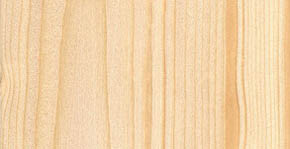
- Janka Hardness: 490 lbf (2,180 N)
- Elastic Modulus: 1,560,000 lbf/in2 (10.76 GPa)
Brazilian Rosewood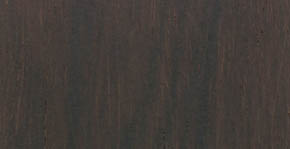
- Janka Hardness: 2,790 lbf (12,410 N)
- Elastic Modulus: 2,020,000 lbf/in2 (13.93 GPa)
Honduran Mahogany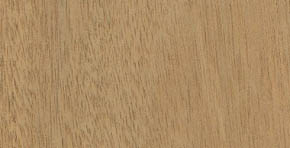
- Janka Hardness: 900 lbf (4,020 N)
- Elastic Modulus: 1,458,000 lbf/in2 (10.06 GPa)
Red Maple
- Janka Hardness: 950 lbf (4,230 N)
- Elastic Modulus: 1,640,000 lbf/in2 (11.31 GPa)
Here’s one that was meant to be loud, a 1944 Gibson J45 with maple back and sides.
The Nut And Saddle – More Volume?
While not conclusive, many players say that changing from a softer material like hardwood or more commonly hard plastic to a hard material like bone or Tusq can increase volume.
This could certainly be true since the string vibration should be more readily transferred into the guitar body, however is also likely to change the tone of the instrument.
If you’re looking for that bit more volume then this is something you can try – just keep your original nut and saddle in case the tone changes to something you aren’t happy with.
TIP
Some good materials for a change are bone, Tusq, or another option that works very well is Corian (commonly used for kitchen benchtops).
The Final Wrap: Who Makes The Loudest Acoustic Guitar?
Clearly, given all the models we found to be considered loud, you can’t really single this question down to one single guitar.
A couple of stats we found on particular guitars were 103-105db for the Martin Bluegrass 16, and 98-100 db for a Collings D2HA.
This may only give a rough idea of guitar output volume, as these figures weren’t obtained under any defined testing method.
Even if you performed testing, every player plays differently, and then there’s the type and age of the strings, what material the nut and saddle are made from, and what type of pick is being used.
If you have thousands of dollars burning a hole in your pocket and you want loads of volume, then look at vintage Archtop guitars – these were explicitly made to complement big band instruments.
Here’s a few we found mention of:
- Epiphone Broadway (1946).
- Vintage Epiphone Emperor / Super Deluxe.
- Gibson Super 400 (1934 onward).
- D’Angelico New Yorker (1936-1964).
- Stromberg Master 400 (1950).
If you’re after a well-known brand, then there are plenty of Taylor’s, Martin’s, and Guild’s that will be plenty loud enough – and more importantly play with a great tone.
If you like new technology, then get your hands on a Rainsong carbon guitar, as carbon fiber has great resonance.
So, if you’re looking for a loud acoustic guitar you can start with this guide to steer you toward some likely candidates, and your next step will be to get out there and play as many as you can get your hands on.
When you eventually find that perfect cannon, I think you will love it possibly more for its tone and playability than its sound volume alone.
Sources
https://www.wood-database.com/



